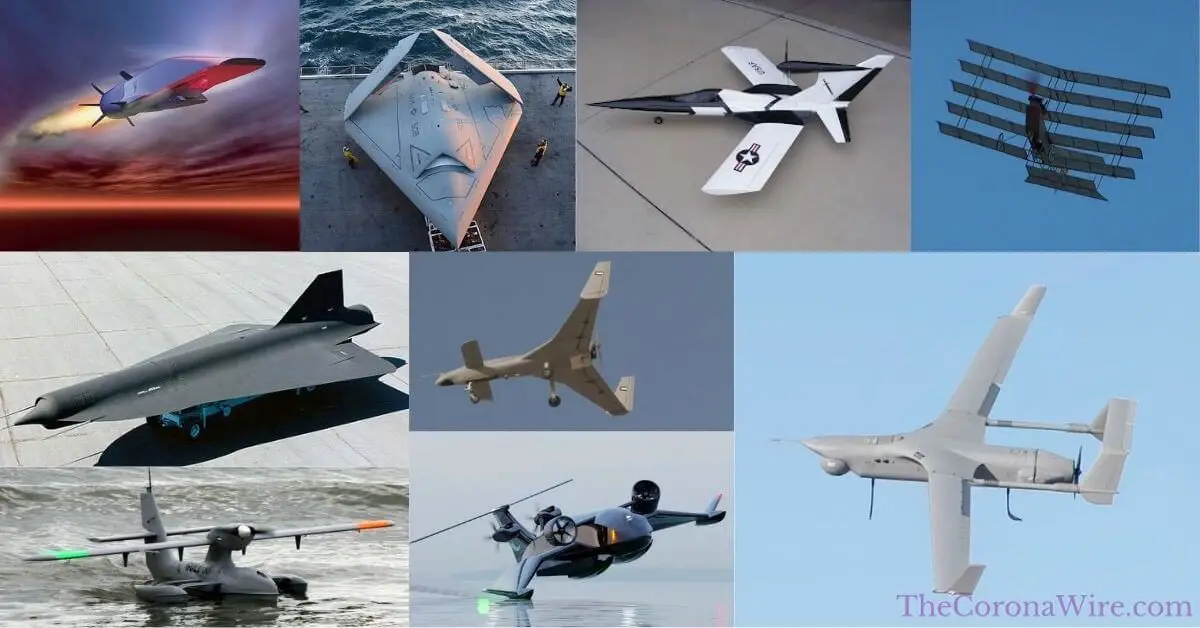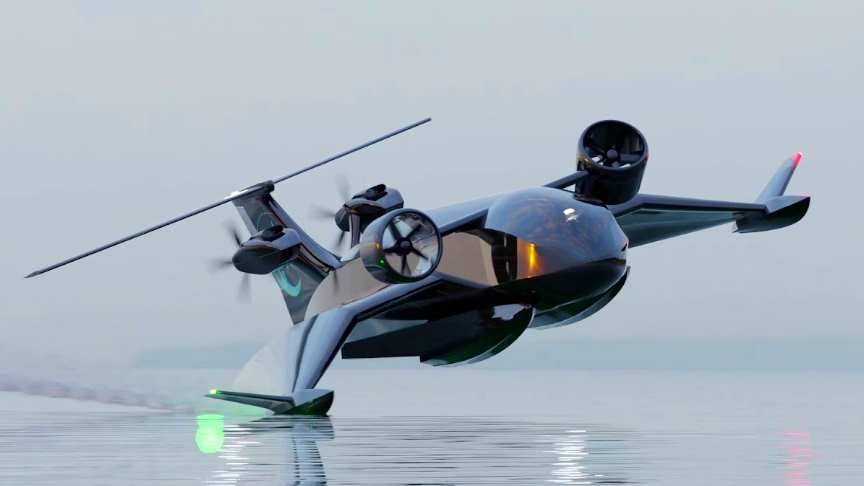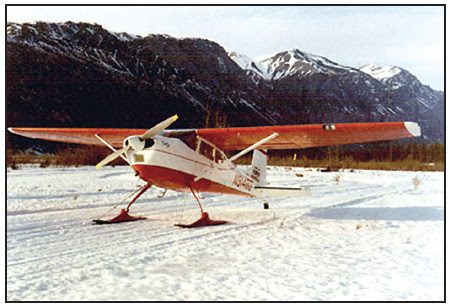Fixed-wing drones/unmanned aerial vehicles are some of the most popular types of drones used today. There are several different types that have been used in commercially successful, and experimental fixed-wing UAVs.
The types of fixed-wing drones/UAVs can be split up according to:
- The general types (unmanned seaplanes, gliders etc)
- The general shapes/designs (Conventional wing, flying wing etc)
- The number of wing planes (Monoplanes, biplanes etc)
- The wing configurations (Variable sweep wings, folding wings etc)
- The empennage and foreplane configurations (Tailless, unmanned canards etc)
In this post, we’re going to cover every type of fixed-wing unmanned aerial vehicle (UAV) with details on how each of them works, an image of each specific type, some quick advantages and disadvantages, the primary things that type is used for, and an example of a real drone of that type.
Take note that we will not be including unmanned aerial robots that are not considered drones such as guided missiles and glide bombs as these are single use devices.
- A Quick Overview On What Fixed-Wing Drones/UAVs Are And How They Work
- General Types Of Fixed-Wing Drones/UAVs
- General Fixed-Wing Drone/UAV Shapes/Designs
- Types Of Fixed-Wing Drones/UAVs According To The Number Of Wing Planes
- Fixed-Wing Drone/UAV Wing Configurations
- Fixed-Wing Drone/UAV Empennage And Foreplane Configurations
- Conclusion
A Quick Overview On What Fixed-Wing Drones/UAVs Are And How They Work
Fixed-wing drones/UAVs are unmanned robotic aircraft that have the ability to generate lift through the use of their lifting surfaces and powerplant among other devices such as propellers for propulsion.
We highly recommend you check out our full detailed post on drone propellers including the different types, how they work, their different sizes and pitch, their materials, how to choose them and much more.
Related Post: Drone Propellers Explained: Detailed Beginner’s Guide To Drone Anatomy
The wing/airfoil is sized and shaped in a way that captures the flow of air as the aircraft’s airspeed increases which in turn generates lift.
Air flows faster on the curved top side of the wing than on the flatter underside due to its shape. This causes less air pressure to accumulate on the top of the wing creating a suction that lifts the wing up enabling both unmanned fixed-wing and rotary-wing drones to fly.
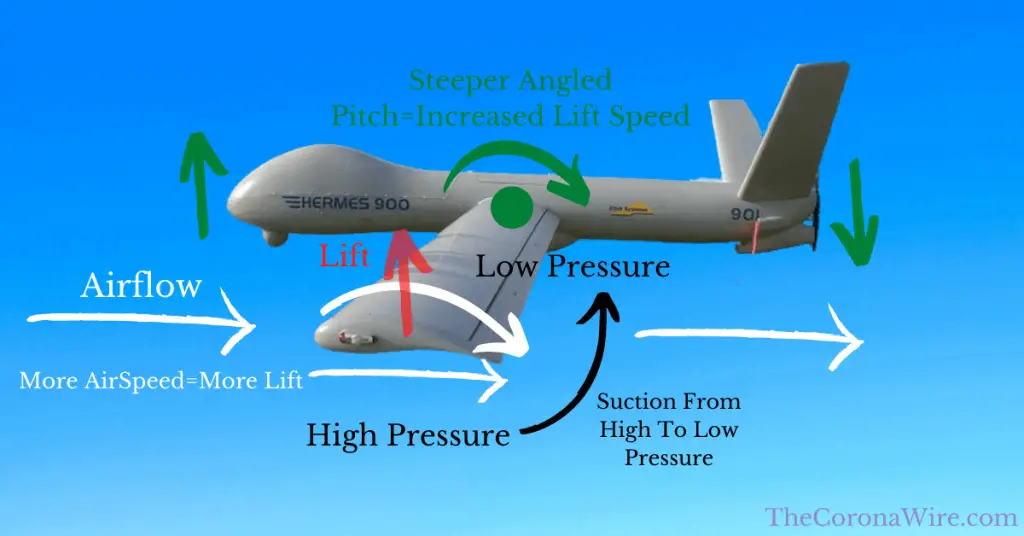
Check out our full post that dives further into how fixed-wing unmanned aerial vehicles (UAVs) work, the differences between fixed-wing and rotary-wing UAVs, fixed-wing drone applications, some parts/components that make them up, advantages/disadvantages, powerplants that are used in them and some real examples of fixed-wing UAVs:
Related Post: What Are Fixed-Wing Drones/UAVs? Everything You Need To Know
General Types Of Fixed-Wing Drones/UAVs
This section includes all the general types of fixed-wing UAVs that make up a large part of fixed-wing UAVs.
Here are the 4 general types of fixed-wing unmanned aerial vehicles (UAVs):
- Unmanned Seaplanes
- Unmanned Gliders/Sailplanes
- Unmanned Ground Effect Vehicles (GEVs)
- Unmanned Skiplanes/Ski-Equipped Drones/UAVs
Unmanned Seaplanes
Unmanned seaplanes are fixed-wing unmanned aerial vehicles (UAVs) that are capable of taking off and landing on the surface of a body of water.
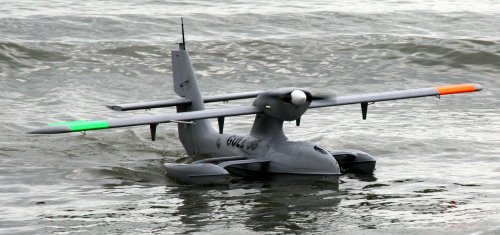
The two types of unmanned seaplanes include floatplanes which are equipped with floats at the base of their undercarriage to act as a flotation device and flying boats which use a watertight hull for buoyancy instead of floats.
Unmanned seaplanes that can takeoff and land both on land and water are called unmanned amphibious aircraft/amphibians.
Unmanned seaplanes are still fairly new in the drone industry. Some can be equipped with various payloads which enable them to conduct ocean surveys, carry out maritime ISR (Intelligence, Surveillance, and Reconnaissance), and potentially transport freight and passengers to certain water-based locations.
The primary advantage of unmanned seaplanes is the fact that they can takeoff and land on any body of water providing much greater flexibility compared to conventional aircraft.
However, they cannot takeoff and/or land when there are strong/high waves and have trouble taking off and/or landing in extreme ocean environments. They also require a sufficient length water strip to takeoff and land.
The Gull 36 (Flying boat) seen in the image above made by Warrior Aero and the U650-A1 (Unmanned Amphibious Flying Boat) made by Shanghai UVS Intelligence System are two examples of unmanned seaplanes.
Check out our full post where we dive into how unmanned seaplanes work, the different types, applications, parts, advantages/disadvantages, and several examples of real drones:
Related Post: What Are Unmanned Seaplanes? Floating Drones Explained
Unmanned Gliders/Sailplanes
Unmanned gliders/sailplanes are fixed-wing unmanned aerial vehicles (UAVs) that use the reaction of rising air (updrafts) flowing against their lifting surfaces (wings, empennage etc) to generate lift.
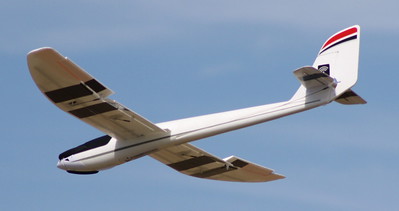
The two types of unmanned sailplanes include unpowered gliders and motor gliders (powered). They can either be launched by a catapult launcher or towed by another aircraft (aerotow) to takeoff.
Check out our full post where we dive into several power sources currently used in drones. For each power source, we expand on how they work, the different types, the advantages, disadvantages, and real-world examples of drones that use it.
Related Post: How Are Drones Powered? 6 Drone Energy Sources Explained
Gliders are primarily used for recreation within the DIY RC (radio/remote control) community.
They are very useful as they can theoretically fly for nearly an indefinite amount of time as long as there’s rising air. They’re also very efficient due to how they’re designed.
However, gliders are typically unpowered which makes them fly relatively slow and allows little room for error from the operator.
The Aquila (unpowered) made by Airtronics and the Model V (motor glider) made by Eclipson are two examples of unmanned gliders/sailplanes.
Here is our full post where we explain how unmanned gliders function, their types, applications, advantages/disadvantages and examples of real drone gliders:
Related Post: What Are Unmanned Gliders? Drone Sailplanes Explained
Unmanned Ground Effect Vehicles (GEVs)
Unmanned ground effect vehicles (GEVs), also called wing-in-ground-effect (WIG) crafts, are fixed-wing unmanned aerial vehicles (UAVs) that use ground effect which is the principle where a flying fixed-wing object experiences far less aerodynamic drag when flying close to any flat fixed surface (land, water, ice etc).
Unmanned GEVs are still in the early development phases as of now but may become commonplace in the near future. There have however been several manned GEVs built successfully.
There are no general types of unmanned GEVs. These vehicles can however be separated by wing configuration. These configurations include the straight wing, reverse-delta wing, and tandem wing unmanned GEVs.
Check out our article where we explain what each part and component of a fixed-wing UAV is, how they work, the different sub-types of each component (if any), and some real examples of either the part/component itself or UAVs that have some of these parts:
Related Post: Main Fixed-Wing Drone/UAV Parts & Components Explained
These vehicles have the potential to significantly improve commercial delivery by sea as they can replace large container ships.
They are much more energy-efficient than vehicles of similar sizes and configurations and they can travel much faster, much further than conventional container ships.
However, the speed they travel compared to the amount of cargo they can transport may not be as cost-efficient and time saving as a conventional container ship. This will primarily depend on how much the specific drone can carry and how fast and far it can travel.
The unmanned GEV Flying Wing concept (seen in the image above) designed by The Flying Wing Company is an example of a future unmanned GEV.
Check out our post where we dive into what unmanned GEVs are, how they work, the types of GEVs, applications, common parts/components, advantages/disadvantages and examples:
Related Post: What Are Unmanned Ground-Effect Vehicles (GEVs)?
Unmanned Skiplanes (Ski-Equipped Drones/UAVs)
Unmanned skiplanes, often referred to as ski-equipped drones/UAVs, are fixed-wing unmanned aerial vehicles (UAVs) that are equipped with skis as landing gear and that are capable of taking off from and landing on snow and ice.
Unmanned Skiplanes can either be equipped with plain aircraft skis (wheel replacement skis, clamp-on skis, or roll-on/full board skis) or combination aircraft skis (retractable skis, penetration skis).
Skiplanes are primarily used to reach locations that are difficult to access. These include frozen lakes, snow and ice-covered runways.
These vehicles are capable of operating in a much wider range of environments compared to conventional unmanned fixed-wing aircraft.
However, the skis are vulnerable to sharp objects while landing on rough surfaces such as ice.
The skis are also vulnerable to extreme cold temperatures which could potentially cause them to shatter on contact. This is worsened by the fact that the purpose of these aircraft is to constantly operate in these conditions.
General Fixed-Wing Drone/UAV Shapes/Designs
This section includes all the shapes and designs fixed-wing drones/UAVs can use. Each design has their own benefits and drawbacks and is typically chosen according to the way the drone will be used.
Here are the 4 general types of fixed-wing unmanned aerial vehicles (UAVs) according to shape/design:
- Conventional wing
- Flying wing
- Blended wing-body
- Lifting body
Conventional wing UAVs
Conventional wing unmanned aerial vehicles (UAVs) are fixed-wing drones/UAVs with a distinct fuselage, wings, and empennage that typically takeoff and land on runways.
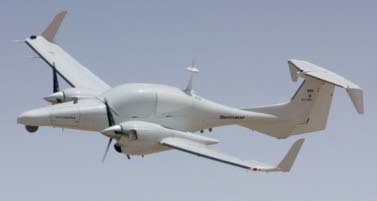
The conventional wing drone shape is the most popular design used in UAVs today. It’s used in drones that carry out almost any task.
This design is efficient, reliable, and flexible which is why it’s so common in both manned and unmanned aircraft.
However, it does have limits. Conventional wing UAVs cannot be used once the aircraft surpasses a certain speed as the configuration of the wings could not support it. This will depend on the wing’s sweep; whether it’s forward/backwards or straight (more on this below).
The Dominator (seen in the image above) made by Aeronautics Defense Systems (ADS) and the Hermes 900 made by Elbit Systems are examples of conventional wing UAVs.
Flying wing UAVs
Flying wing unmanned aerial vehicles (UAVs) are tailless fixed-wing drones/UAVs with no distinct fuselage that use the reaction of air flowing against the body of the drone which is essentially a large wing to generate lift.
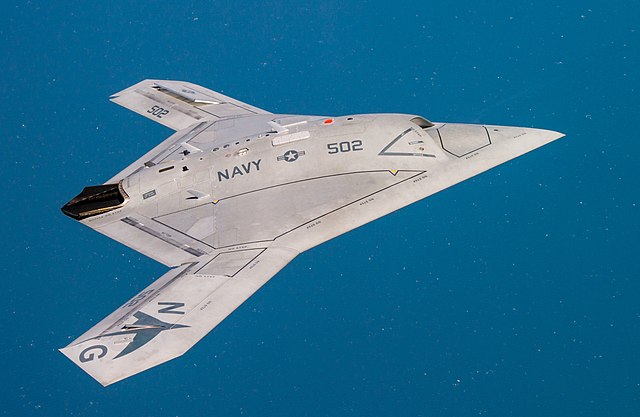
There are not many successful flying wing drones as there are still many issues with the design. The drones using this design that are currently in production are primarily used in the military for ISR (Intelligence, Surveillance, and Reconnaissance) operations.
Check out our full post on several fixed-wing UAV applications where we explain what each is, how fixed-wing drones are used in them, how they’re beneficial typically over manned aircraft, and some real examples/concepts if there are any:
Related Post: 12 Awesome Fixed-Wing Drone/UAV Applications Explained
These UAVs can be much more efficient as the aircraft is essentially a large wing/airfoil improving the rate lift is generated and reducing aerodynamic drag.
These drones are typically unstable and difficult to control as there is a lack of aerodynamic devices which help control and stabilise the aircraft.
The X-47B (seen in the image above) made by Northrop Grumman and the S-70 Okhotnik-B made by Sukhoi are two examples of flying wing UAVs.
Blended wing-body (BWB) UAVs
Blended wing-body (BWB) unmanned aerial vehicles (UAVs) are drones/UAVs without a clear dividing line between the distinct wings and fuselage as they’re smoothly blended together. These aircraft can have a tail or be tailless and this design is used in both aircraft and underwater gliders.
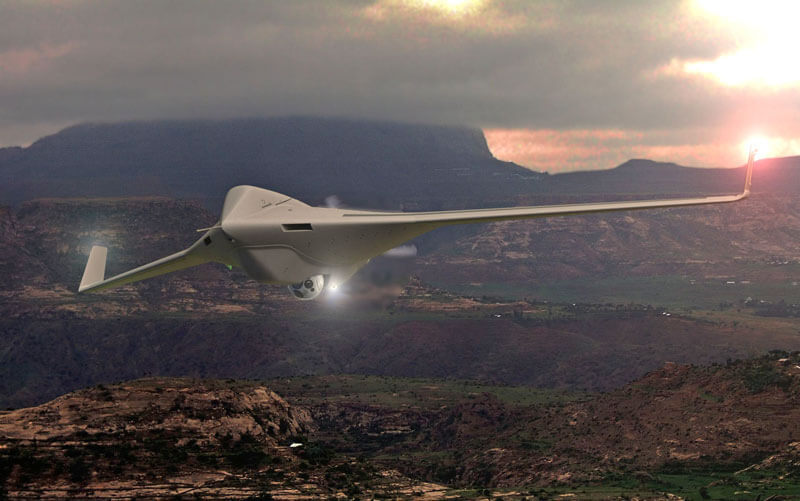
These types of UAVs can often resemble flying wing drones. However, the difference is that BWB UAVs have a fuselage and can have a tail if required whereas flying wing drones cannot have a tail assembly or a conventional fuselage.
These aircraft are primarily used in the military for ISR (Intelligence, Surveillance, and Reconnaissance) operations and also by institutions for research purposes.
Check out our post on military UAV flight range where we compare manned to unmanned military flight range, we talk about the factors that impact maximum flight range, and we take a look at some military UAVs with the longest range today:
Related Post: How Far Can Military Unmanned Aerial Vehicles (UAVs) Fly?
The design of the aircraft can be much more efficient compared to conventional wing aircraft enabling the drone to carry much heavier payloads for much longer and farther distances.
Like flying wing UAVs, these types of fixed-wing drones require large wingspans and various aerodynamic devices (flaps, wingtips etc) to help stabilise and control the aircraft even if it has an empennage/tail assembly.
The Fury 1500 (seen in the image above) made by Lockheed Martin and the Taranis made by BAE Systems are two examples of blended wing-body (BWB) UAVs.
Lifting body UAVs
Lifting body unmanned aerial vehicles (UAVs) are fixed-wing drones/UAVs that do not use conventional wings, instead relying on their fuselage to generate lift. This design can be used in both unmanned aircraft and unmanned spacecraft.
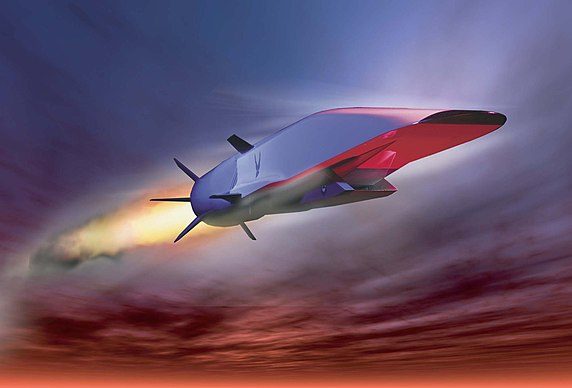
This design is primarily used for drones that are intended to operate at subsonic, supersonic and hypersonic flight or in spacecraft in the re-entry process.
These types of aircraft add many benefits compared to conventional wing UAVs such as reduced drag, better fuel efficiency, and the ability to fly faster than most other types of drones as they do not require wings.
Check out out full post where we dive into the average flight times for both consumer and commercial drones, including the average drone battery life expectancies, the types of drone batteries, why drones have short flight times and battery life expectancies, how to increase both and more:
Related Post: How Long Does A Drone Battery Last? Battery Life Expectancy + Flight Times
However, they typically have very fast landing speeds and can be dangerous as they have to deploy their landing gear late compared to conventional wing UAVs.
The X-51 Waverider (seen in the image above) made by Boeing and the X-43A/Hyper-X made by NASA are two examples of lifting body UAVs.
Types Of Fixed-Wing Drones/UAVs According To The Number Of Wing Planes
Take note that a wing plane refers to a full wing from one wingtip to the other on an aircraft. A mainplane refers to the primary wing plane a drone uses to generate lift. A tailplane refers to the horizontal wing located on the tail assembly of an aircraft.
Here are the 5 types of fixed-wing unmanned aerial vehicles (UAVs) according to the number of wing planes:
- Unmanned monoplanes (1 wing planes)
- Unmanned biplanes (2 wing planes)
- Unmanned triplanes (3 wing planes)
- Unmanned quadruplanes (4 wing planes)
- Unmanned multiplanes (5 or more wing planes)
Unmanned monoplanes
Unmanned monoplanes are drones/unmanned aerial vehicles (UAVs) with a single primary wing/mainplane.
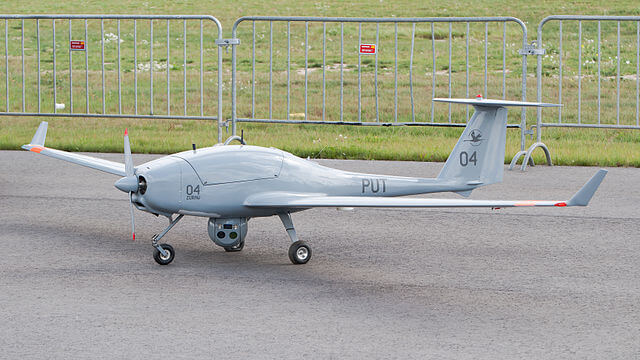
This is the most common type of UAV used today. This mainplane (primary wing plane on an aircraft) may be placed in several positions relative to the UAV’s fuselage (low wing, mid wing, shoulder wing etc).
One wing planes give the drone a good balance in aerodynamic performance. This wing configuration gives the aircraft the highest efficiency and the lowest drag.
However, this configuration is not ideal for things such as low-speed aerobatics as the wing cannot typically handle as much stress as the other types below.
The Zurau UAV (seen in the image above) made by the Mobile Systems Research Laboratories (MSRL) and the Institute of Computing Science and the Vanilla (VA001) made by Vanilla Unmanned are two examples of unmanned monoplanes.
Unmanned biplanes
Unmanned biplanes are drones/unmanned aerial vehicles (UAVs) with two primary wings/mainplanes that are similar in size and are vertically stacked on top of each other.
Take note that biplanes are not the same thing as tandem wing UAVs (more on this below).
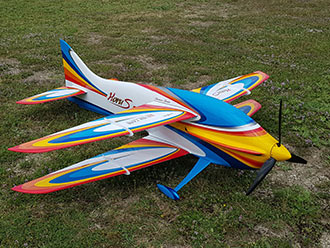
This mainplane configuration is very popular due to its added advantages over aircraft with fewer mainplanes.
Check out our post that explains all fixed-wing UAV advantages and disadvantages:
Related Post: 11 Fixed-Wing Drone/UAV Advantages+Disadvantages Explained
This configuration has a structural advantage over monoplanes as they can be built to have lighter wing structures and provide the aircraft with far more lift due to the added surface area.
However, the added wings which are often accompanied by struts or wires to stiffen the entire structure and support it under stress increase the amount of drag.
The HoruS Biplane (seen in the image above) made by Sebart and the Dynam Pitts model 12 made by Dynam are two examples of unmanned biplanes.
Unmanned triplanes
Unmanned triplanes are drones/unmanned aerial vehicles (UAVs) with three primary wings/mainplanes that are similar in size and are vertically stacked on top of each other.
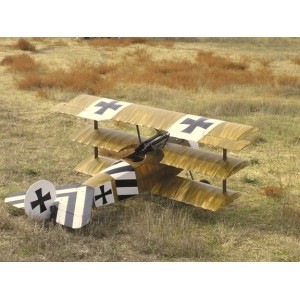
These types of aircraft are primarily used in the RC community to represent the famous WW1 fighter aircraft of the same name.
This wing configuration provides more of the same aerodynamic advantages as biplanes such as increased efficiency and lift and more manoeuvrability than biplanes as the wingspan of the mainplanes can be shorter.
However, more mainplanes mean more struts and/or wires are required which increases drag.
The RC Fokker triplane (seen in the image above) made by Balsa USA as a kit is an example of an unmanned triplane.
Unmanned quadruplanes
Unmanned quadruplanes are drones/unmanned aerial vehicles (UAVs) with four primary wings/mainplanes that are similar in size and are vertically stacked on top of each other.
Take note that quadruplanes are different from quadplanes (hybrid fixed-wing/VTOL rotor/winged craft).
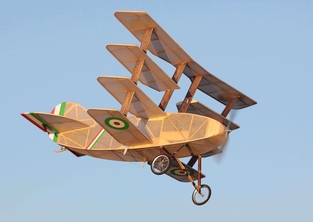
These types of aircraft are often rare to find and no manned or unmanned quadruplane has ever truly been commercially successful.
This configuration takes all the same advantages and disadvantages associated with triplanes to another level. Due to how rare they are to find, there has not been as much research put into this design compared to the above wing configurations.
Unmanned multiplanes
Unmanned multiplanes are drones/unmanned aerial vehicles (UAVs) with five or more primary wings/mainplanes that are similar in size and are either vertically stacked on top of each other or are placed one in front of the other (like steps).
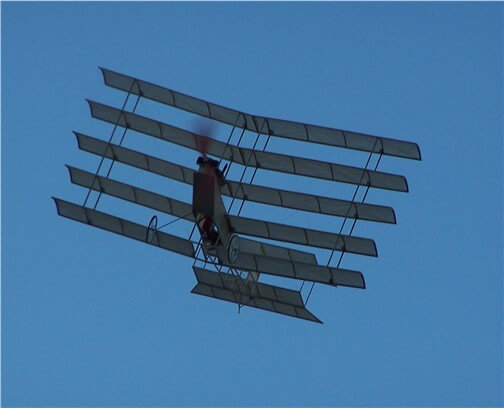
Now, these types of aircraft are very rare and almost never built. Although they do look awesome!
Fixed-Wing Drone/UAV Wing Configurations
This section includes all the configurations used on the wings of an unmanned aircraft. The shape of an aircraft’s wing can drastically affect the overall performance of the aircraft.
Here are the 6 wing configurations used in fixed-wing unmanned aerial vehicles (UAVs):
- Variable-sweep wings
- Folding wings
- Swept wings
- Delta wings
- Tandem wings
- Straight wings
Variable-Sweep Wing UAVs
Variable-sweep wing unmanned aerial vehicles are fixed-wing drones/UAVs that can sweep both their wings/mainplanes forwards but typically only backwards at the same time and return them to their original position during flight.
Although these types of aircraft have wings that aren’t fixed in a single position, they are still considered to be fixed-wing aircraft. These aircraft are a sub-category of variable geometry aircraft (any UAV capable of changing configuration while flying).
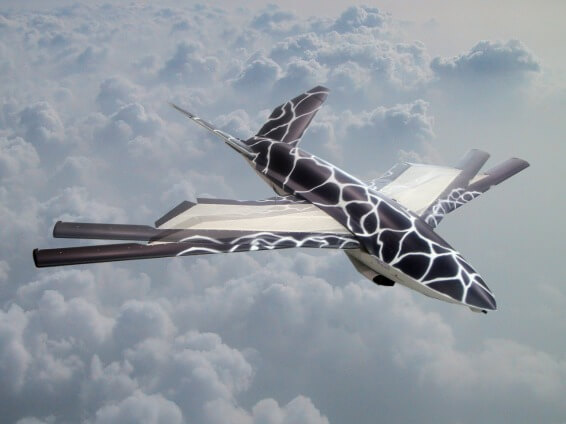
These types of drones are used in UAVs that are meant to fly both at regular speeds and transition into high-speed flight.
This fixed-wing configuration ensures that each point in the aircraft’s flight is optimised to its fullest potential from the straight wing for takeoff and low-speed flight to the swept wing for high-speed flight.
Check out our post which goes into common and uncommon terminology and abbreviations used in the drone industry with individual definitions for each:
Related Post: 300+ Drone Terminology and Abbreviation Definitions Explained
However, the mechanisms enabling the variable-sweep functionalities cause the aircraft to have high maintenance costs and add to the weight of the craft negatively affecting its overall performance.
The MFX-1 (seen in the image above) made by NextGen Aeronautics and the Variable Sweep Flying Wing made by Kevin Shen at the Olympia High School in Washington are two examples of variable-sweep wing UAVs.
Folding Wing UAVs
Folding wing unmanned aerial vehicles (UAVs) are fixed-wing drones/UAVs that can fold their wings either during flight, for storage, or both. Their folding wings can include mainplanes, tailplanes, or their entire tail assembly/empennage.
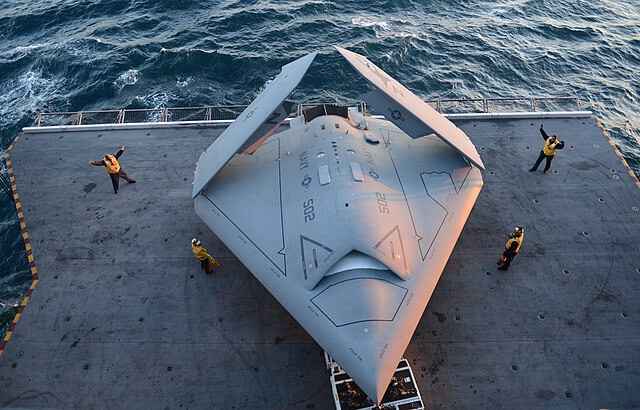
The two types include folding wing UAVs that fold their wings during flight for high-speed flight which are another sub-category of variable geometry aircraft and those that can only fold their wings for storage which are not considered variable geometry aircraft.
Some hybrid fixed-wing/VTOL aircraft have also utilised the folding wing configuration, extending their mainplanes once the vehicle has reached a suitable height to transition into horizontal flight.
We have a detailed post where we dive into how VTOL drones work, the types of VTOL drones according to flight modes, designs, and propulsion methods, their costs, how much they weigh, their payload capacities, use cases, examples, and more:
Related Post: What Are Vertical Takeoff And Landing (VTOL) Drones? (+hybrid variants)
Some aircraft can also fold their entire tail assemblies/empennages for storage.
The folding wing configuration is very beneficial in regards to the amount of space the UAV takes up while it is stored. This is especially useful with drones that operate from an aircraft carrier.
However, these mechanisms that enable them to fold can become complex and heavy and can also get stuck which can potentially negatively impact the drone.
The X-47B (seen in the image above) made by Northrop Grumman and the ASN-213 made by Aisheng Technology Group are two examples of folding wing UAVs.
Swept Wing UAVs
Swept wing unmanned aerial vehicles (UAVs) are fixed-wing drones/UAVs with wings/mainplanes that are swept either forwards or backwards.
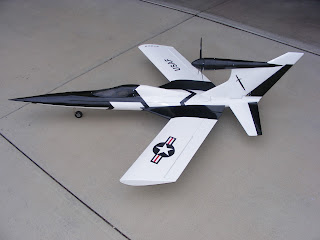
These types of drones are similar to variable-sweep wing UAVs in that they can have forward or backward swept wings, although they are fixed in place.
They are typically used for drones that are built for high-speed flights as this wing configuration has far less drag at transonic speeds.
Check out our post on military UAV flight speeds where we compare manned to unmanned military flight speeds, we talk about the factors that impact maximum flight speed, and we take a look at some of the fastest military UAVs today:
Related Post: How Fast Do Military Unmanned Aerial Vehicles (UAVs) Fly?
However, the fuel consumption is greater at subsonic flight compared to an un-swept aircraft.
The Dagger (seen in the image above) made by the RC hobbyist Crazzyflyer and the RQ-15 Neptune (forward swept) made by DRS Unmanned Technologies are two examples of swept wing UAVs.
Delta Wing UAVs
Delta wing unmanned aerial vehicles (UAVs) are fixed-wing drones/UAVs that have a swept back triangular planform (shape/outline of an aircraft wing) and a straight trailing edge.
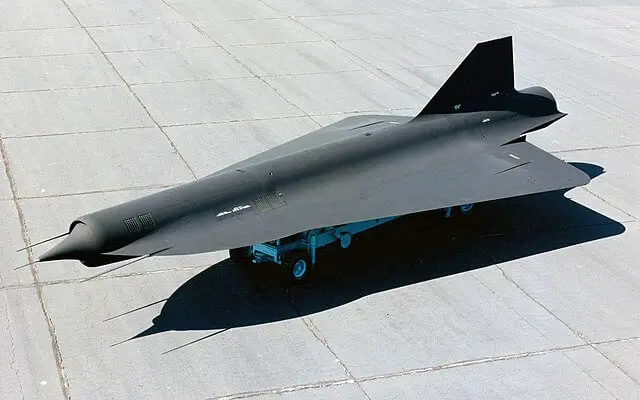
There are five types of delta wing drones. These include tailless delta, tailed delta, cropped delta, compound delta, and ogival delta UAVs. There have also been canard delta aircraft that use a canard foreplane.
These types of UAVs incorporate most of the same advantages as swept wing UAVs in that they are very efficient in high-speed flights as the wing has far less drag.
However, these aircraft have a high angle of attack at low speeds in order to generate enough lift until they increase airspeed as the wings experience high drag at such speeds. This forces the aircraft to use a lot of fuel during takeoff.
The D-21 (seen in the image above) made by Lockheed Martin and the Demon made by BAE Systems are two examples of delta wing UAVs.
Tandem Wing UAVs
Tandem wing unmanned aerial vehicles (UAVs) are fixed-wing drones/UAVs that have two mainplanes/primary wings which both generate lift placed one in front of the other. These wings must be different in aerodynamic characteristics such as different aerofoils chosen for each wing.
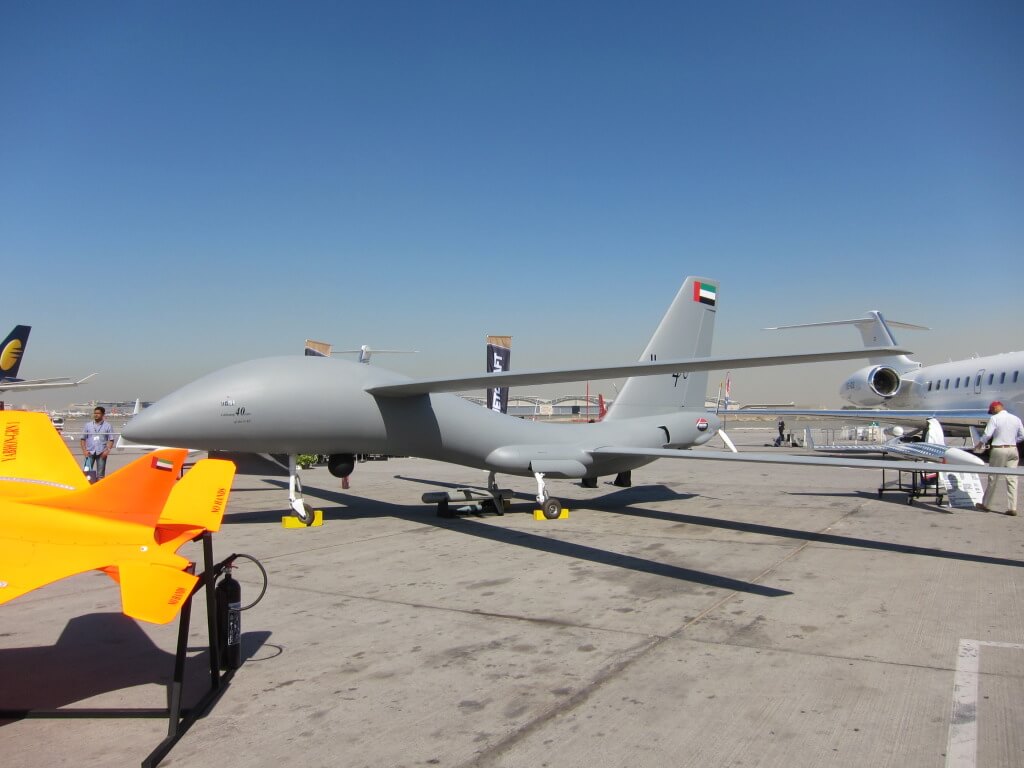
These types of drones differ from Delanne wing aircraft where the rear tandem wing is much smaller than the forward wing. They also differ from canards where the foreplane is much smaller and primarily provides control and/or stability.
This configuration has also been used in unmanned ground effect vehicles (GEVs).
Since both mainplanes contribute to generating lift, the aircraft’s wingspan is far shorter compared to conventional wing drones.
However, the rear mainplane is prone to downwash (air deflected by flowing around an airfoil) from the front mainplane which negatively effects the rear mainplane reducing the drone’s efficiency.
The Yabhon United 40 (seen in the image above) made by ADCOM Systems and the Talisman made by Elytron Aeronautica are two examples of tandem wing UAVs.
Straight Wing UAVs
Straight wing unmanned aerial vehicles (UAVs) are fixed-wing drones/UAVs that have wings/mainplanes that extend horizontally to the aircraft’s fuselage.
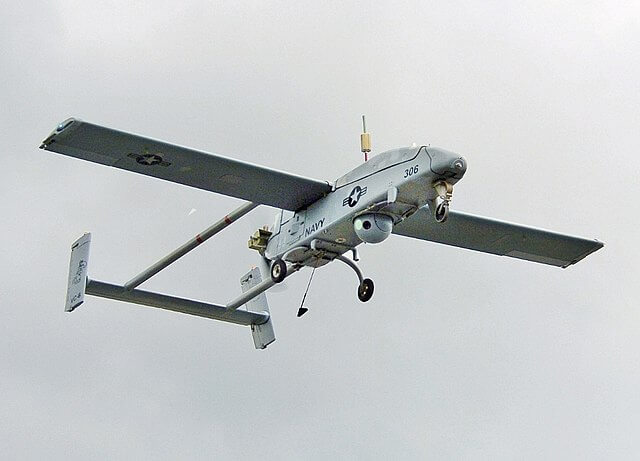
These types of UAVs are primarily used in drone’s meant to operate at subsonic speeds.
This configuration is considered the most structurally-efficient wing which is why it is probably one of the most commonly used configurations in drones.
However, the drone will experience high drag at high airspeeds reducing the aircraft’s efficiency.
The RQ-2 Pioneer (seen in the image above) made by AAI Corporation with Israel Aircraft Industries and the Orion-E made by Kronshtadt Group are two examples of straight wing UAVs.
Fixed-Wing Drone/UAV Empennage And Foreplane Configurations
The types of fixed-wing UAVs can also be separated according to the configuration of the empennage/tail assembly and foreplane.
An empennage/tail assembly is the entire tail configuration which includes a fin (vertical stabiliser) and rudder which acts vertically and a horizontal tailplane/stabiliser and elevator which act horizontally.
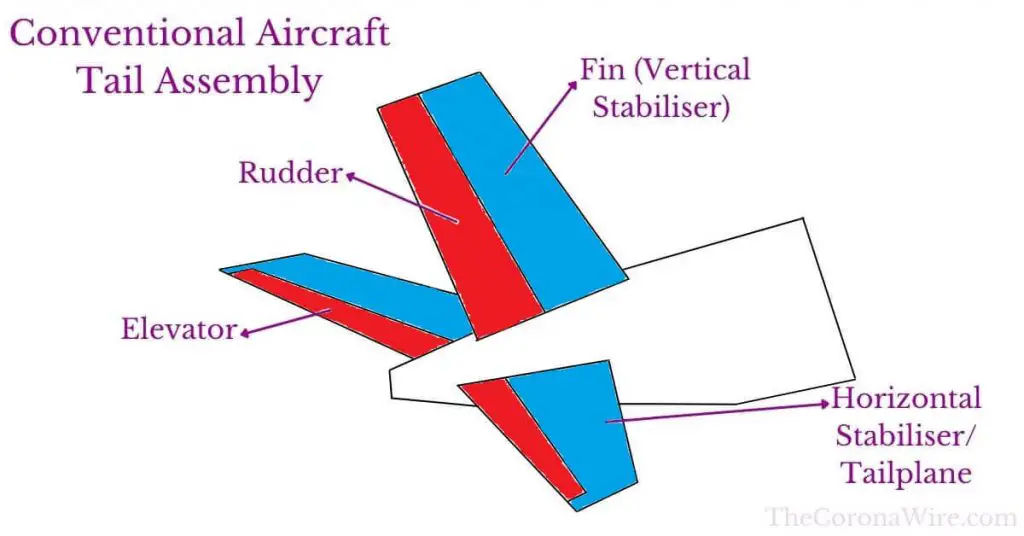
A foreplane is a horizontal wing located at the front of a drone. Foreplanes include the tandem mainplane located at the front of the drone and canards.
Here are 6 types of fixed-wing unmanned aerial vehicles (UAVs) according to the empennage/tail assembly and foreplane configuration:
- Conventional empennage/tail assembly
- T-tail empennage
- V-tail empennage
- Twin-boom empennage
- Tailless
- Unmanned Canards
Although these types of empennages are not used solely on fixed-wing UAVs, the following will be focusing primarily on these types of aircraft.
Conventional empennage/tail assembly UAVs
Conventional empennage/tail assembly unmanned aerial vehicles (UAVs) are drones/UAVs that have a fin (vertical stabiliser) and rudder acting vertically, but especially a tailplane (horizontal stabiliser) and elevator acting horizontally typically mounted to the fuselage under the fin.
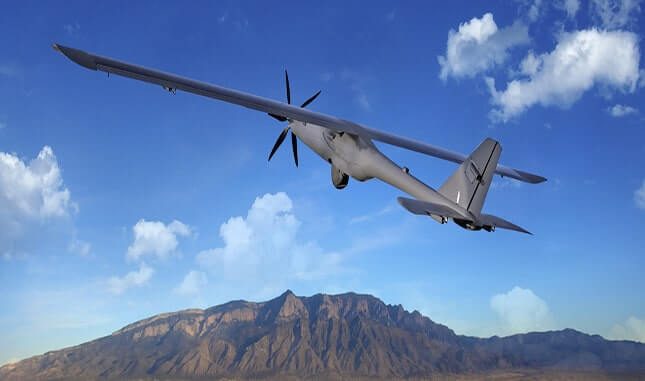
This is the conventional empennage used in many drones.
This provides the aircraft with a good balance of stability and control.
The Silent Falcon (seen in the image above) made by Silent Falcon UAS Technologies with Bye Aerospace and the Finder (Flight Inserted Detector Expendable for Reconnaissance) made by Naval Research Laboratory (NRL) are two examples of conventional empennage/tail assembly UAVs.
T-tail empennage UAVs
T-tail empennage unmanned aerial vehicles (UAVs) are drones/UAVs that have a fin (vertical stabiliser) and rudder acting vertically, and a tailplane (horizontal stabiliser) and elevator acting horizontally mounted to the top of the fin.
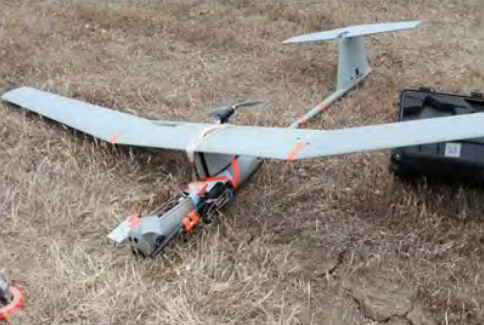
The T-tail configuration is useful when trying to keep the stabilisers out of the engine’s wake and give better control over the pitch of the aircraft.
This configuration is most beneficial for drones that travel at relatively low speeds and intend on gliding.
These types of empennages tend to be much stronger making them heavier than conventional tail assemblies and are more prone to enter a stall.
The FQM-151 Pointer (seen in the image above) made by AeroVironment and the Vanilla (VA001) made by Vanilla Unmanned are two examples of T-tail empennage UAVS.
V-tail empennage UAVs
V-tail empennage unmanned aerial vehicles (UAVs) are drones/UAVs that have twin tail control surfaces called ruddervators which act as both a rudder and elevator.
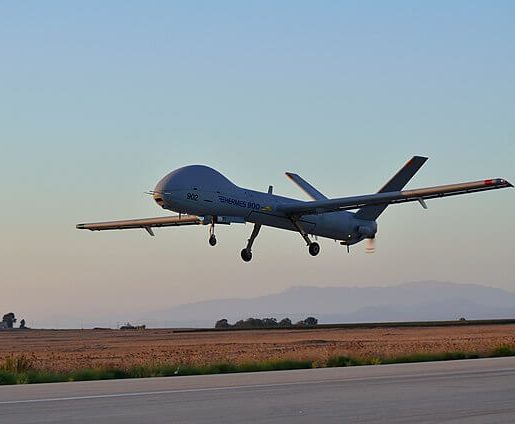
The two types of V-tail empennages include the conventional V-tail which has twin ruddervators facing upwards and the inverted V-tail which has twin ruddervators facing downwards.
These types of empennages tend to produce less drag than conventional tail assemblies in many situations and are generally lighter.
However, these types of aircraft require longer tails extending their fuselages as they experience yawing (movement of a drone around its yaw axis) when the length of the fuselage is not adequate introducing several safety concerns.
The Hermes 900 (seen in the image above) made by Elbit Systems and the MQ-1 Predator made by General Atomics are two examples of V-tail empennage UAVs.
Twin-boom empennage UAVs
Twin-boom empennage unmanned aerial vehicles (UAVs) are drones/UAVs that have twin booms which each have their own fins (vertical stabilisers) and a tailplane (horizontal stabiliser) and sometimes twin ruddervators between the fins connecting them.
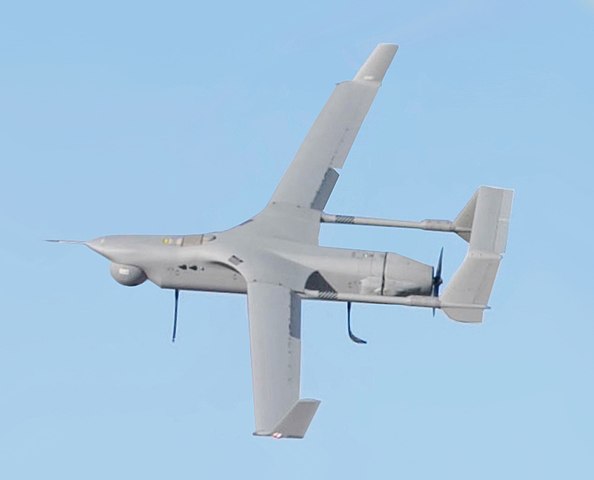
These types of UAVs are not often built but there have still been several successful twin-boom drones.
These types of drones can be made to be lighter and smaller in size due to a reduced tip effect acting on the tailplanes.
These types of empennages generally increase drag compared to conventional tail assemblies.
The RQ-21 Blackjack (seen in the image above) made by Boeing’s subsidiary company Insitu and the FVR–90 (Fixed Wing VTOL Rotator) made by L3Harris Technologies are two examples of twin-boom empennage UAVs.
If you’d like to discover who the best drone companies are in the world for the consumer, commercial and military drone markets and some fun facts about them, we have a full post on this topic below:
Related Post: Top Drone Companies/Manufacturers In The World [History, What They Offer, Popular Drones And More]
Tailless UAVs
Tailless unmanned aerial vehicles (UAVs) are drones/UAVs that have no empennage/tail assembly. However, they can have a tail fin and rudder but no other horizontal surface besides the mainplane.
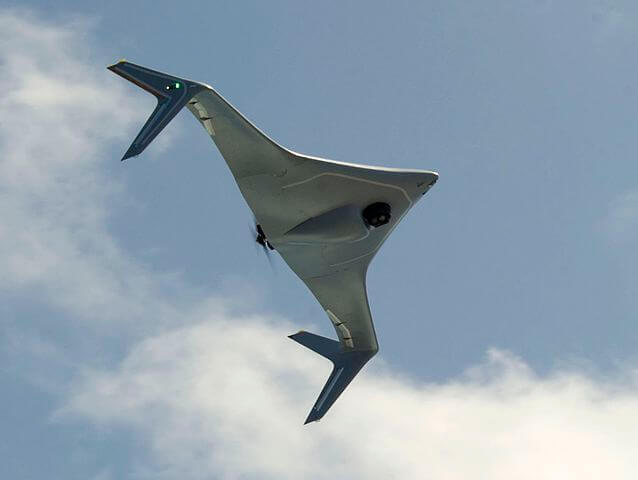
The tailless UAV includes types such as tailless delta and flying wing drones.
These types of drones are supposed to experience less drag compared to UAVs with conventional empennages as they lack tailplanes (horizontal stabilisers).
However, they tend to be unstable during flight if not properly designed.
The Bat (seen in the image above) made by Northrop Grumman and the nEUROn made by Dassault Aviation are two examples of tailless UAVs.
Unmanned Canards
Unmanned Canards are drones/unmanned aerial vehicles (UAVs) that have a small foreplane mounted to the nose of the fuselage in front of the mainplane (main wing).
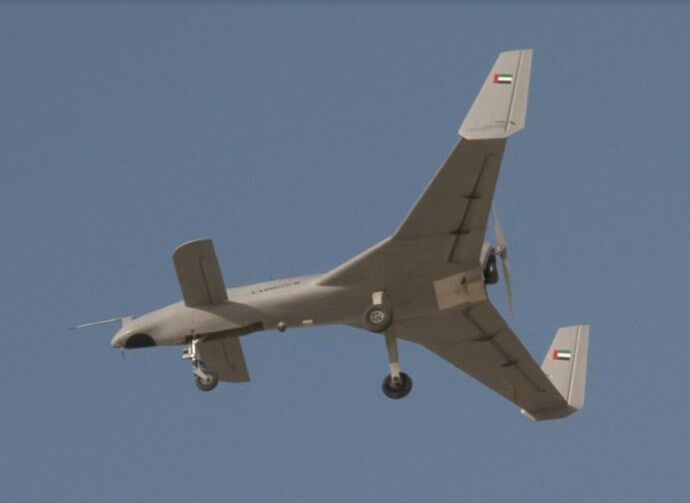
There are two types of canards. These are the lifting canard (which is placed in a way to increase the lift generated) and the control canard (which is placed in a way to aid in the overall control of the aircraft and stability).
A canard can help increase the drone’s stability and can also help control the mainplane’s airflow.
However, these types of UAVs can change the centre of gravity of the drone making them unstable if not properly designed. This may force manufacturers to shift components and fuel tank inside the fuselage which can become troublesome.
The size of the canard is also essential to get right. Placing a canard that is not the ideal size can negatively impact the UAV’s performance.
The Yabhon R (seen in the image above) made by Adcom Systems and the Shahpar made by Global Industrial Defence Solution are two examples of unmanned canards.
Conclusion
As you can see, there are various different types of fixed-wing unmanned aerial vehicles (UAVs). We hope you discovered a type of drone you were not familiar with and understood how it works. Make sure you check out our primary post on what fixed-wing UAVs are.
